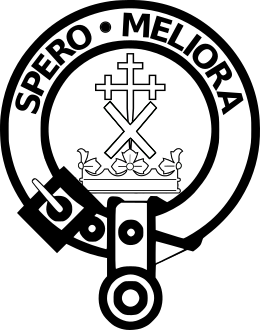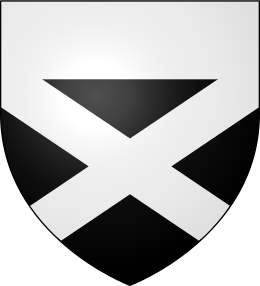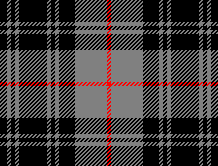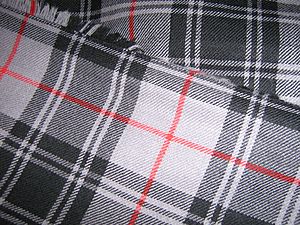Clan Moffat facts for kids
Quick facts for kids Clan Moffat |
|||
|---|---|---|---|

Crest: a crest coronet and issuing therefrom a cross crosslet fitchee Sable surmounted of a saltire Argent.
|
|||
| Motto | Spero meliora (I aspire to greater things) | ||
| Profile | |||
| Region | Borders | ||
| District | Dumfriesshire | ||
| Chief | |||
 |
|||
| Jean Moffat of that Ilk, | |||
| Chief of the Name and Arms of Moffat. | |||
| Seat | St Jasual, Wheeler End, Buckinghamshire | ||
|
|||
Clan Moffat is an old Scottish clan from the Lowlands. For a long time, from the mid-1500s until 1983, the clan didn't have a recognized leader. But then, Francis Moffat was officially named the hereditary chief by the Lord Lyon King of Arms, who is like Scotland's expert on coats of arms and clans.
Contents
History of Clan Moffat
Where Did the Moffats Come From?
The Moffat family comes from the Scottish Borders. They were a strong and important family even during the time of William Wallace, a famous Scottish hero. It's thought that the family's ancestors gave their name to the town of Moffat in Dumfriesshire. The name Moffat might even have come from the Norse people.
An early ancestor, William de Movat Alto, married a daughter of Andlaw, who came to Scotland from Norway in the 900s. Over time, the family name changed from Montealt to Movat, then Movest, and finally to Moffat. By the 1100s, they were known as "de Moffet," which showed they were important landowners.
Nicholas de Moffat became the Bishop of Glasgow in 1286. The special symbols (armorial bearings) of different parts of the clan often show a link to the church.
Moffats and Scotland's Fight for Freedom
In 1300, Robert the Bruce, who was then the Lord of Annandale, gave the Moffats four land charters in Westerkirk. One of these was for Adam Moffat of Knock. Adam and his brother, along with many other Moffat clansmen, fought bravely at the Battle of Bannockburn in 1314. This was a very important battle during the Wars of Scottish Independence.
In 1336, the King of England allowed William de Moffete and others to travel safely as ambassadors to David II of Scotland. Walter de Moffat, who was a church official in Lothian, was also sent as an ambassador to France in 1337.
Before 1300, there were Moffats in the town of Moffat, but their names aren't known. In 1342, they gained control of lands called Granton and Reddings from Sir John Douglas. These lands were the main properties of the clan until they had to be given to the Clan Johnstone in 1628 due to large debts.
Clan Conflicts in the 1500s
Like many other Border clans, the Clan Moffat were known as Border Reivers. This meant they would often raid and have conflicts with other clans. Their main rivals were the powerful Clan Johnstone.
There are stories that the Johnstones were involved in the death of Robert Moffat, who might have been the clan chief, in 1557. It's also said they burned a building where Moffats had gathered, harming those who tried to escape. However, these stories don't have clear historical proof. After this time, the Clan Moffat was considered to be without a chief until 1983.
The Modern Clan Moffat
For over 400 years, the clan didn't have a chief. But in 1983, after a lot of research, Francis Moffat was officially recognized as the hereditary chief by the Lord Lyon King of Arms. This meant he could use the special undifferenced Arms of Moffat of that Ilk. In April 1992, the role of chief passed to his daughter, Jean Moffat of that Ilk.
Clan Moffat Profile
What Does the Name Moffat Mean?
The last name Moffat comes from a place name, the town of Moffat in Dumfriesshire. It's thought to have come from the Norman language and then changed with Gaelic influences. Some people think it means "the long plain," from the words magh (plain) and fada (long).
However, the area around Moffat doesn't really look like a "long plain." So, another idea is that "Moffat" was how locals tried to say "Mowat." The Mowats, Moffats, and Montaltos families all share a common ancestor and once had the same family symbols. Records from the 1300s show someone named "Monte Alto," which was pronounced "Mowat." This is an example of how Norman names changed over time. For example, Belvoir Castle is pronounced "Beaver Castle" because it was easier for local people to say. In the same way, Monte Alto (pronounced "Mowat") became Movvat, and then "very easily changed to Moffat."
Clan Chief, Crest, and Motto
- Clan Chief: Jean Moffat of that Ilk, who is the official Chief of the Name and Arms of Moffat.
- Clansman's Badge: A clan member can wear a badge. It has the special symbol (Crest) from the Chief's Arms, surrounded by a strap and buckle. The Moffat Chief's crest shows "a crest coronet and coming out from it a cross crosslet fitchee Sable with a saltire Argent on top."
- Clan Motto: The clan motto is "Spero meliora." This is Latin for I hope for better things.
The Moffat Clan Tartan
The Moffat family tartan is quite new. It was created by Major Francis Moffat of that Ilk after he became the clan chief in 1983. This tartan looks a lot like the Clan Douglas tartan.
Major Francis Moffat explained in his book, "The Moffats," that he chose the colors for the modern tartan (black, silver, and a little bit of red) from the oldest family symbols (arms coats) linked to the Moffats. These old symbols showed a black lion standing on its hind legs on a silver background, with red teeth and claws.
See also



